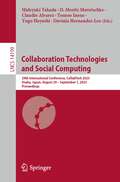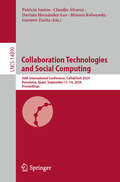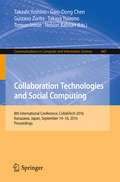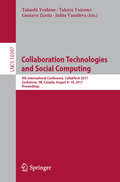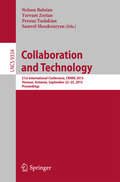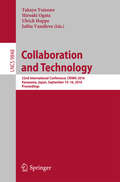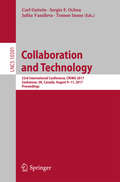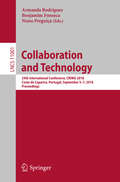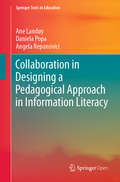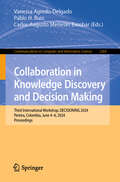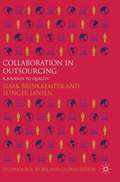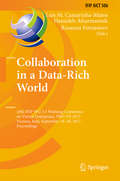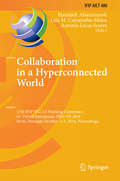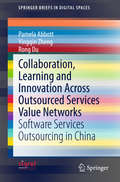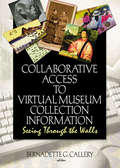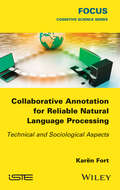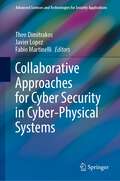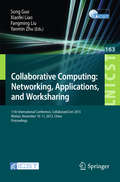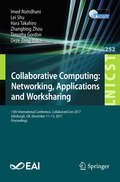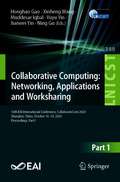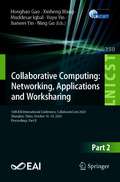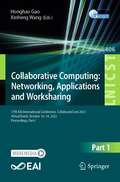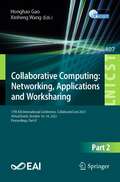- Table View
- List View
Collaboration Technologies and Social Computing: 29th International Conference, CollabTech 2023, Osaka, Japan, August 29–September 1, 2023, Proceedings (Lecture Notes in Computer Science #14199)
by Tomoo Inoue Yugo Hayashi Hideyuki Takada Claudio Alvarez D. Moritz Marutschke Davinia Hernandez-LeoThis book constitutes the refereed proceedings of the 29th International Conference on Collaboration Technologies and Social Computing, CollabTech 2023, held in Osaka, Japan, during August 29–September 1, 2023, in hybrid mode. The 8 full papers presented in this book together with 12 short papers were carefully reviewed and selected from 31 submissions. The papers focus on innovative technical, human and organizational approaches to expand collaboration support including computer science, management science, design science, cognitive and social science.
Collaboration Technologies and Social Computing: 30th International Conference, CollabTech 2024, Barcelona, Spain, September 11–14, 2024, Proceedings (Lecture Notes in Computer Science #14890)
by Gustavo Zurita Davinia Hernández-Leo Patricia Santos Claudio Álvarez Minoru KobayashiThis book constitutes the proceedings of the 30th International Conference on Collaboration Technologies and Social Computing, CollabTech 2024, held in Barcelona, Spain, during September 11–14, 2024. The 12 full papers and 10 short papers included in this book were carefully reviewed and selected from 85 submissions. The papers present up to date research on theory, models, design principles, methodologies, and case studies that contribute to a better understanding of the complex interrelations between collaboration and technology.
Collaboration Technologies and Social Computing: 8th International Conference, CollabTech 2016, Kanazawa, Japan, September 14-16, 2016, Proceedings (Communications in Computer and Information Science #647)
by Nelson Baloian Takaya Yuizono Takashi Yoshino Gwo-Dong Chen Gustavo Zurita Tomoo InoueThis book constitutes the refereed proceedings of the 7th International Conference on Collaboration Technologies, CollabTech 2014, held in Santiago, Chile, in September 2014. The 10 revised full papers presented together with 4 short papers and a keynote were carefully reviewed and selected from 34 submissions. The papers are organized in topical sections on Collaborative Problem Solving; Knowledge Work and CSCW Tasks; Co-Dining Support; Augmented Reality and Robot; Learning Support Systems.
Collaboration Technologies and Social Computing: 9th International Conference, CollabTech 2017, Saskatoon, SK, Canada, August 8–10, 2017, Proceedings (Lecture Notes in Computer Science #10397)
by Julita Vassileva Takaya Yuizono Takashi Yoshino Gustavo ZuritaThis book constitutes the refereed proceedings of the 7th International Conference on Collaboration Technologies, CollabTech 2014, held in Santiago, Chile, in September 2014. The 10 revised full papers presented together with 4 short papers and a keynote were carefully reviewed and selected from 34 submissions. The papers are organized in topical sections on Collaborative Problem Solving; Knowledge Work and CSCW Tasks; Co-Dining Support; Augmented Reality and Robot; Learning Support Systems.
Collaboration Technologies and Social Computing: 9th International Conference, CollabTech 2017, Saskatoon, SK, Canada, August 8–10, 2017, Proceedings (Lecture Notes in Computer Science #10397)
by Julita Vassileva Takaya Yuizono Takashi Yoshino Gustavo ZuritaThis book constitutes the refereed proceedings of the 9th International Conference on Collaboration Technologies, CollabTech 2017, held in Saskatoon, SK, Canada, in August 2017. The 10 revised full papers presented in this book together with 6 short papers were carefully reviewed and selected from 37 submissions. The papers focus on topics such as: CSCW system architectures and applications; social computing; crowdsourcing; inter-cultural collaboration; collaborative communication systems; embodied collaboration systems; shared virtual/augmented environments; smart devices for collaboration; computer supported collaborative learning (CSCL); collaborative entertainment systems; computer supported cooperative design (CSCD); and social science studies on collaboration.
Collaboration and Technology: 21st International Conference, CRIWG 2015, Yerevan, Armenia, September 22-25, 2015, Proceedings (Lecture Notes in Computer Science #9334)
by Nelson Baloian Yervant Zorian Perouz Taslakian Samvel ShoukouryanThis book constitutes the refereed proceedings of the 21st International Conference on Collaboration and Technology, CRIWG 2015, held in Yerevan, Armenia, in September 2015. The 19 revised papers presented together with 1 invited talk were carefully reviewed and selected from 28 submissions. CRIWG has been focused on collaboration technology design, development, and evaluation. The background research is influenced by a number of disciplines, such as computer science, management science, informationsystems, engineering, psychology, cognitive sciences, and social sciences.
Collaboration and Technology: 22nd International Conference, CRIWG 2016, Kanazawa, Japan, September 14-16, 2016, Proceedings (Lecture Notes in Computer Science #9848)
by Julita Vassileva Hiroaki Ogata Takaya Yuizono Ulrich HoppeThis book constitutes the proceedings of the 20th Collaboration Researchers' International Working Group Conference on Collaboration and Technology, held in Santiago, Chile, in September 2014. The 16 revised papers presented together with 18 progress papers and 3 invited talks were carefully reviewed and selected from 49 submissions. The papers published in proceedings of this year's and past CRIWG conferences reflect the trends in collaborative computing research and its evolution. There was a growing interest in social networks analysis, crowdsourcing and computer support for large communities in general. A special research topic which has been traditionally present in the CRIWG proceedings has been collaborative learning.
Collaboration and Technology: 23rd International Conference, CRIWG 2017, Saskatoon, SK, Canada, August 9-11, 2017, Proceedings (Lecture Notes in Computer Science #10391)
by Julita Vassileva Sergio F. Ochoa Tomoo Inoue Carl GutwinIt was approximately two decades ago that the support of communication and collaboration became an important research issue. The technical stimulation for this was the spread of personal computers and computer networks, whilst the social driver was the demand for the support of everyday work, frequently including group work and teamwork. This field of research has become known as Computer-Supported Cooperative Work whilst the systems to support group work are called groupware. Over the two decades, research has been extensively conducted. Various Web-based systems have been researched, some of which are aimed at the support of communication and collaboration. Mobile phones have spread rapidly and communication and collaboration support systems have also been researched on this platform. There are many other technologies such as virtual reality, robotics, multimedia, and ubiquitous computing, each of which provides opportunities for the research field. As the research field is not dependent on the type of technology, but is dependent on the needs of human activity and human beings are social animals, the technical demands of supporting social activities do not diminish. Technologies that potentially are useful for this purpose are being investigated whilst new technologies are invented. As a result of the development of IT, the research and development of communication and collaboration systems is increasingly active. The scope of this publication extends from perspectives, design principles, guidelines, and social aspects of communication and collaboration support systems to the various application systems and the platform technologies.
Collaboration and Technology: 24th International Conference, CRIWG 2018, Costa de Caparica, Portugal, September 5-7, 2018, Proceedings (Lecture Notes in Computer Science #11001)
by Armanda Rodrigues Benjamim Fonseca Nuno PreguiçaThis book constitutes the refereed proceedings of the 24th International Conference on Collaboration and Technology, CRIWG 2018, held in Costa de Caparica, Portugal, in September 2018.The 11 revised full papers presented together with 6 short papers were carefully reviewed and selected from 32 submissions. The papers published in the proceedings of this year span dierent areas of collaborative computing research, from collaborative learning to collaboration through social media and virtual communities.
Collaboration in Designing a Pedagogical Approach in Information Literacy (Springer Texts in Education)
by Ane Landøy Daniela Popa Angela RepanoviciThis Open Access book combines expertise in information literacy with expertise in education and teaching to share tips and tricks for the development of good information literacy teaching and training in universities and libraries. It draws on research, knowledge and pedagogical practice from academia, to teach students how to sift through information to be able to distinguish the important and correct from the unusable. It discusses basic concepts and models of information literacy, as well as strategies for accessing, locating and retrieving information and methods suitable for the assessment and management of information. The book explains many concepts connected to information literacy and discusses pedagogical issues with a view to supporting the practitioner. Each chapter examines one aspect of information literacy, discusses the pedagogical challenges involved and provides suggestions for best practice.
Collaboration in Knowledge Discovery and Decision Making: Third International Workshop, DECISIONING 2024, Pereira, Colombia, June 4–6, 2024, Proceedings (Communications in Computer and Information Science #2369)
by Vanessa Agredo-Delgado Pablo H. Ruiz Carlos Augusto Meneses EscobarThis book CCIS 2369 constitutes the proceedings of the Third International Workshop on Collaboration in Knowledge Discovery and Decision Making, DECISIONING 2024, held in Pereira, Colombia, during June 4–6, 2024. The 18 full papers were carefully reviewed and selected from 54 submissions. These papers explore recent advances in collaborative decision making and knowledge discovery, addressing topics including data analysis, artificial intelligence, decision models and industrial applications.
Collaboration in Outsourcing
by Sjaak Brinkkemper Slinger JansenAlthough IT outsourcing is nothing new, it remains surprisingly challenging for professionals. This book assists the IT professional in several areas of the outsourcing process: establishing outsourcing relationships, maintaining and managing the relationship, and finally governing outsourcing projects successfully.
Collaboration in a Data-Rich World: 18th IFIP WG 5.5 Working Conference on Virtual Enterprises, PRO-VE 2017, Vicenza, Italy, September 18-20, 2017, Proceedings (IFIP Advances in Information and Communication Technology #506)
by Luis M. Camarinha-Matos, Hamideh Afsarmanesh and Rosanna FornasieroThis book constitutes the refereed proceedings of the 18th IFIP WG 5.5 Working Conference on Virtual Enterprises, PRO-VE 2017, held in Vicenza, Italy, in September 2017. The 68 revised full papers were carefully reviewed and selected from 159 submissions. They provide a comprehensive overview of identified challenges and recent advances in various collaborative network (CN) domains and their applications, with a strong focus on the following areas: collaborative models, platforms and systems for data-rich worlds; manufacturing ecosystem and collaboration in Industry 4.0; big data analytics and intelligence; risk, performance, and uncertainty in collaborative data-rich systems; semantic data/service discovery, retrieval, and composition in a collaborative data-rich world; trust and sustainability analysis in collaborative networks; value creation and social impact of collaboration in data-rich worlds; technology development platforms supporting collaborative systems; collective intelligence and collaboration in advanced/emerging applications: collaborative manufacturing and factories of the future, e-health and care, food and agribusiness, and crisis/disaster management.
Collaboration in a Hyperconnected World: 17th IFIP WG 5.5 Working Conference on Virtual Enterprises, PRO-VE 2016, Porto, Portugal, October 3-5, 2016, Proceedings (IFIP Advances in Information and Communication Technology #480)
by Luis M. Camarinha-Matos Hamideh Afsarmanesh António Lucas SoaresThis book constitutes the refereed proceedings of the 17th IFIP WG 5. 5 Working Conference on Virtual Enterprises, PRO-VE 2016, held in Porto, Portugal, in October 2016. The 57 revised papers were carefully reviewed and selected from 148 submissions. They provide a comprehensive overview of identified challenges and recent advances in various collaborative network (CN) domains and their applications, with a strong focus on the following areas: hyperconnected systems, managing data and knowledge, networked business processes, collective intelligence and decision making, creating supply and production networks, operating and management of networks, collaborative engineering, product services, intelligent product ecosystems, product personalization, service orientation, cloud technology aspects for VOs, design science research, business models in hyperconnected context, agribusiness value chain, and collaborative networks in circular economy.
Collaboration in the Digital Age: How Technology Enables Individuals, Teams and Businesses (Progress in IS)
by Kai Riemer Stefan Schellhammer Michaela MeinertThis book examines how digital technologies enable collaboration as a way for individuals, teams and businesses to connect, create value, and harness new opportunities. Digital technologies have brought the world closer together but also created new barriers and divides. While it is now possible to connect almost instantly and seamlessly across the globe, collaboration comes at a cost; it requires new skills and hidden ‘collaboration work’, and the need to renegotiate the fair distribution of value in multi-stakeholder network arrangements. Presenting state-of-the-art research, case studies, and leading voices in the field, the book provides academics and professionals with insights into the diverse powers of collaboration in the digital age, spanning collaboration among professionals, organisations, and consumers. It brings together contributions from scholars interested in the collaboration of teams, cooperatives, projects, and new cooperative systems, covering a range of sectors from the sharing economy, health care, large project businesses to public sector collaboration.
Collaboration, Learning and Innovation Across Outsourced Services Value Networks: Software Services Outsourcing in China (SpringerBriefs in Digital Spaces)
by Pamela Abbott Yingqin Zheng Rong DuThis book collects and reports on the results of a study conducted on the Chinese Software and Services Outsourcing (SSO) industry, focusing on one of its main players as a key case study. Two sets of research findings are presented: first, the knowledge management and communication processes inherent within a highly collaborative software development project between the case study company and one of its long-term UK clients are explored and distilled into specific practices; second, at the organizational level, the strategies used by the company to build and exploit capabilities and to dynamically configure resources to promote specific value positions along its outsourced services value networks are identified and discussed. The significance of these findings for similar China-based global high-tech firms and the value of this organizational form in moving closer to the goals of the 2020 enterprise vision are both discussed, along with the implications of the findings for EU/UK businesses operating in similar digital domains.
Collaborative Access to Virtual Museum Collection Information: Seeing Through the Walls
by John J Riemer Bernadette G CalleryGet practical tools to successfully develop collaborative online learning projects!Virtual museums provide an opportunity to spark learning through online access to multi-sensory information, and collaboration between sources is needed to efficiently and effectively catalog and present material. Collaborative Access to Virtual Museum Co
Collaborative Annotation for Reliable Natural Language Processing: Technical and Sociological Aspects
by Karën FortThis book presents a unique opportunity for constructing a consistent image of collaborative manual annotation for Natural Language Processing (NLP). NLP has witnessed two major evolutions in the past 25 years: firstly, the extraordinary success of machine learning, which is now, for better or for worse, overwhelmingly dominant in the field, and secondly, the multiplication of evaluation campaigns or shared tasks. Both involve manually annotated corpora, for the training and evaluation of the systems. These corpora have progressively become the hidden pillars of our domain, providing food for our hungry machine learning algorithms and reference for evaluation. Annotation is now the place where linguistics hides in NLP. However, manual annotation has largely been ignored for some time, and it has taken a while even for annotation guidelines to be recognized as essential. Although some efforts have been made lately to address some of the issues presented by manual annotation, there has still been little research done on the subject. This book aims to provide some useful insights into the subject. Manual corpus annotation is now at the heart of NLP, and is still largely unexplored. There is a need for manual annotation engineering (in the sense of a precisely formalized process), and this book aims to provide a first step towards a holistic methodology, with a global view on annotation.
Collaborative Approaches for Cyber Security in Cyber-Physical Systems (Advanced Sciences and Technologies for Security Applications)
by Javier Lopez Fabio Martinelli Theo DimitrakosThis book describes cyber-security issues underpinning several cyber-physical systems and several application domains, proposing a common perspective able to collect similarities as well as depict divergences and specific solution methods. Special attention is given to those approaches and technologies that unleash the power of collaboration among stakeholders, in a field based often developed in isolation and segregation of information. Given the pervasively growing dependency of society on IT technology, and the corresponding proliferation of cyber-threats, there is both an imperative need and opportunity to develop a coherent set of techniques to cope with the changing nature of the upcoming cyber-security challenges. These include evolving threats and new technological means to exploit vulnerabilities of cyber-physical systems that have direct socio-technical, societal and economic consequences for Europe and the world. We witness cyber-attacks on large scale infrastructures for energy, transport, healthcare systems and smart systems. The interplay between security and safety issues is now paramount and will be even more relevant in the future. The book collects contributions from a number of scientists in Europe and presents the results of several European Projects, as NeCS, SPARTA, E-CORRIDOR and C3ISP. It will be of value to industrial researchers, practitioners and engineers developing cyber-physical solutions, as well as academics and students in cyber-security, ICT, and smart technologies in general.
Collaborative Computing: 11th International Conference, CollaborateCom 2015, Wuhan, November 10-11, 2015, China. Proceedings (Lecture Notes of the Institute for Computer Sciences, Social Informatics and Telecommunications Engineering #163)
by Song Guo Xiaofei Liao Fangming Liu Yanmin ZhuThisbook constitutes the thoroughly refereed proceedings of the 11th InternationalConference on Collaborative Computing: Networking, Applications, andWorksharing, CollaborateCom 2015, held in Wuhan, China, in November 2015. The 24 full papers and 8 short papers presented were carefullyreviewed and selected from numerous submissions. They address topics aroundnetworking, technology and systems, including but not limited to collaborativecloud computing, architecture and evaluation, collaborative applications,sensors and Internet of Things (IoT), security.
Collaborative Computing: 13th International Conference, CollaborateCom 2017, Edinburgh, UK, December 11–13, 2017, Proceedings (Lecture Notes of the Institute for Computer Sciences, Social Informatics and Telecommunications Engineering #252)
by Deze Zeng Lei Shu Imed Romdhani Hara Takahiro Zhangbing Zhou Timothy GordonThis book constitutes the thoroughly refereed proceedings of the 13th International Conference on Collaborative Computing: Networking, Applications, and Worksharing, CollaborateCom 2017, held in Edinburgh, UK, in December 2017. The 65 papers presented were carefully reviewed and selected from 103 submissions and focus on electronic collaboration between distributed teams of humans, computer applications, and autonomous robots to achieve higher productivity and produce joint products.
Collaborative Computing: 16th EAI International Conference, CollaborateCom 2020, Shanghai, China, October 16–18, 2020, Proceedings, Part I (Lecture Notes of the Institute for Computer Sciences, Social Informatics and Telecommunications Engineering #349)
by Honghao Gao Jianwei Yin Xinheng Wang Yuyu Yin Muddesar Iqbal Ning GuThis two-volume set constitutes the refereed proceedings of the 16th International Conference on Collaborative Computing: Networking, Applications, and Worksharing, CollaborateCom 2020, held in Shanghai, China, in October 2020.The 61 full papers and 16 short papers presented were carefully reviewed and selected from 211 submissions. The papers reflect the conference sessions as follows: Collaborative Applications for Network and E-Commerce; Optimization for Collaborate System; Cloud and Edge Computing; Artificial Intelligence; AI Application and Optimization; Classification and Recommendation; Internet of Things; Collaborative Robotics and Autonomous Systems; Smart Transportation.
Collaborative Computing: 16th EAI International Conference, CollaborateCom 2020, Shanghai, China, October 16–18, 2020, Proceedings, Part II (Lecture Notes of the Institute for Computer Sciences, Social Informatics and Telecommunications Engineering #350)
by Honghao Gao Jianwei Yin Xinheng Wang Yuyu Yin Muddesar Iqbal Ning GuThis two-volume set constitutes the refereed proceedings of the 16th International Conference on Collaborative Computing: Networking, Applications, and Worksharing, CollaborateCom 2020, held in Shanghai, China, in October 2020.The 61 full papers and 16 short papers presented were carefully reviewed and selected from 211 submissions. The papers reflect the conference sessions as follows: Collaborative Applications for Network and E-Commerce; Optimization for Collaborate System; Cloud and Edge Computing; Artificial Intelligence; AI Application and Optimization; Classification and Recommendation; Internet of Things; Collaborative Robotics and Autonomous Systems; Smart Transportation.
Collaborative Computing: 17th EAI International Conference, CollaborateCom 2021, Virtual Event, October 16-18, 2021, Proceedings, Part I (Lecture Notes of the Institute for Computer Sciences, Social Informatics and Telecommunications Engineering #406)
by Honghao Gao Xinheng WangThis two-volume set constitutes the refereed proceedings of the 17th International Conference on Collaborative Computing: Networking, Applications, and Worksharing, CollaborateCom 2021, held in October 2021. Due to COVID-19 pandemic the conference was held virtually.The 62 full papers and 7 short papers presented were carefully reviewed and selected from 206 submissions. The papers reflect the conference sessions as follows: Optimization for Collaborate System; Optimization based on Collaborative Computing; UVA and Traffic system; Recommendation System; Recommendation System & Network and Security; Network and Security; Network and Security & IoT and Social Networks; IoT and Social Networks & Images handling and human recognition; Images handling and human recognition & Edge Computing; Edge Computing; Edge Computing & Collaborative working; Collaborative working & Deep Learning and application; Deep Learning and application; Deep Learning and application; Deep Learning and application & UVA.
Collaborative Computing: 17th EAI International Conference, CollaborateCom 2021, Virtual Event, October 16-18, 2021, Proceedings, Part II (Lecture Notes of the Institute for Computer Sciences, Social Informatics and Telecommunications Engineering #407)
by Honghao Gao Xinheng WangThis two-volume set constitutes the refereed proceedings of the 17th International Conference on Collaborative Computing: Networking, Applications, and Worksharing, CollaborateCom 2021, held in October 2021. Due to COVID-19 pandemic the conference was held virtually.The 62 full papers and 7 short papers presented were carefully reviewed and selected from 206 submissions. The papers reflect the conference sessions as follows: Optimization for Collaborate System; Optimization based on Collaborative Computing; UVA and Traffic system; Recommendation System; Recommendation System & Network and Security; Network and Security; Network and Security & IoT and Social Networks; IoT and Social Networks & Images handling and human recognition; Images handling and human recognition & Edge Computing; Edge Computing; Edge Computing & Collaborative working; Collaborative working & Deep Learning and application; Deep Learning and application; Deep Learning and application; Deep Learning and application & UVA.
